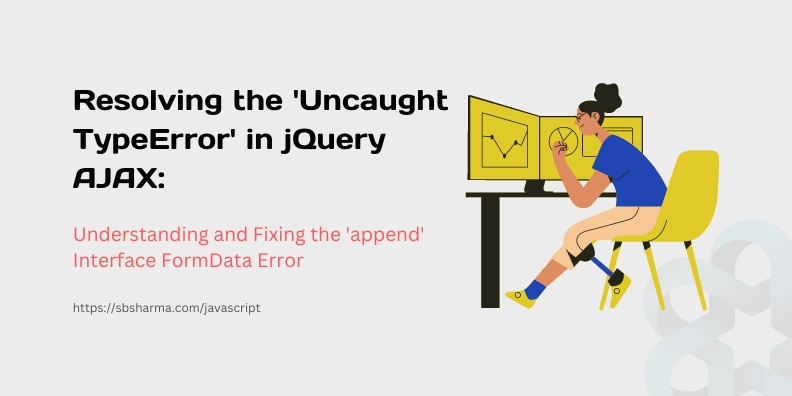Resolving the ‘Uncaught TypeError’ in jQuery AJAX: Understanding and Fixing the ‘append’ Interface FormData Error

Uncaught TypeErrror: append called on an object that does not implement interface FormData.
JQuery has long been a popular choice for simplifying AJAX requests and providing an easier interface to for the DOM.
However, when working with AJAX requests that involve form data and FormData, developers may encounter the ‘Uncaught TypeError’ related to the ‘append’ method. This error arises when the FormData object’s data is not correctly processed during the AJAX request.
In this article, we will explore the causes of this error and demonstrate how to resolve it by appropriately configuring the processData and contentType settings in the jQuery AJAX request.
Understanding the Error “ ‘append’ called on an object that does not implement interface FormData”:
Uncaught TypeError: ‘append’ called on an object that does not implement interface FormData.
The ‘Uncaught TypeError’ error occurs when the append method of the FormData object is called on an invalid object. In this case, it happens when the AJAX request fails to handle the FormData correctly, leading to unexpected behavior during the form data submission process.
Root Cause of the Error ‘Uncaught TypeError’:
By default, jQuery’s AJAX request processes data and sets the Content-Type header based on the provided data object. When using FormData objects, developers often forget to set the appropriate options to instruct jQuery not to process the FormData and to set the correct Content-Type manually.
Consequently, sending the request as plain text rather than as form data results in the ‘Uncaught TypeError’.
Solution:
To resolve the ‘Uncaught TypeError’ related to the append method, it is essential to disable the data processing and set the correct Content-Type header in the jQuery AJAX request. This can be achieved by setting the processData and contentType options appropriately.
1. Setting ‘processData’ to ‘false’:
The processData option instructs jQuery not to process the data being sent. By default, jQuery converts data objects into query strings, which is not suitable for FormData objects.
2. Setting ‘contentType’ to ‘false’:
The contentType option allows you to specify the type of data being sent in the request. When set to false, jQuery does not add a Content-Type header, letting the browser handle the appropriate content type for FormData objects.
Example:
Let’s illustrate how to use processData and contentType to resolve the ‘Uncaught TypeError’ error in a jQuery AJAX request:
<!-- HTML form --> <form id="myForm"> <input type="text" name="username" placeholder="Username" /> <input type="email" name="email" placeholder="Email" /> <button type="button" onclick="submitForm()">Submit</button> </form>
// JavaScript - jQuery AJAX
function submitForm() {
const formElement = document.getElementById('myForm');
const formData = new FormData(formElement);
$.ajax({
url: '/submit',
type: 'POST',
data: formData,
processData: false, // Disable data processing
contentType: false, // Let the browser set the appropriate content type for FormData
success: function(response) {
// Handle the response
},
error: function(error) {
// Handle errors
}
});
}
Conclusion:
Encountering the ‘Uncaught TypeError’ related to the append method while working with jQuery AJAX requests involving FormData is a common issue. By understanding the root cause and configuring the processData and contentType options correctly, you can ensure that the FormData object is handled appropriately during the AJAX request, resolving the error and allowing for smooth form data submission.
Now, armed with this knowledge, you can confidently implement AJAX requests with FormData and overcome any challenges that come your way in web development.




